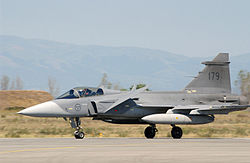Swedish Air Force
| Swedish Air Force | |
|---|---|
| File:Swedish Air Force.png Coat of arms of the Swedish Air Force. | |
| Founded | July 1 1926 |
| Country | Sweden |
| Part of | Swedish Armed Forces |
| Commanders | |
| Current commander | Major General Jan Andersson |
| Insignia | |
| Roundels |   |
| Aircraft flown | |
| Fighter | JAS 39 Gripen |
| Trainer | Saab 105 |
| Transport | C-130 Hercules |
The Swedish Air Force (Swedish: Flygvapnet, literally "The Flying Weapon") is the air force branch of the Swedish Armed Forces, the military of Sweden.
History
The Swedish Air Force was created on July 1 1926 when the aircraft units of the Army and Navy were merged. Because of the escalating international tension during the 1930s the Air Force was reorganized and expanded from 4 to 7 squadrons. When World War II broke out in 1939 further expansion was initiated and this substantial expansion was not finished until the end of the war. Although Sweden never entered the war, a large air force was considered necessary to ward off the threat of invasion and to resist pressure through military threats from the great powers. By 1945 the Swedish Air Force had over 800 combat-ready aircraft, including 15 fighter divisions.
A major problem for the Swedish Air Force during World War Two was the lack of fuel. Sweden was surrounded by countries at war and could not rely on imported oil. Instead domestic oil shales were heated to produce the needed petrol.
Expansion during the Cold War
The Swedish air force underwent a rapid modernization from 1945. It was no longer politically acceptable to equip it with second-rate models. Instead, the air staff purchased the best it could find from abroad, e.g. P-51D Mustangs and de Havilland Vampires, and supported the development of top performance domestic models. When the SAAB Tunnan fighter was introduced around 1950, Sweden suddenly had planes that were equal to the best of the Royal Air Force, Soviet Union and the US Air Force.
During the 1950s the air force started to build road bases after an idea taken from Germany. The bases were ordinary highways constructed in such a way that they could also serve as landing strips. During the Cold War large amounts of money (including all that had been reserved for Swedish nuclear weapons) were spent on the Swedish Air Force and domestic airplane production. In 1957 Sweden had the world's fourth most powerful air force, with about 800 modern planes in front-line service. During the 1950s, it introduced fighters such as the Saab J 29 Tunnan, Saab A 32 Lansen and Saab J 35 Draken.
War Service
The Swedish Air Force has fought in two wars, the Finno-Soviet Winter War in 1939-40 and in the Congo Crisis 1961-64.
Finland 1940
When the Soviet Union attacked Finland in November 1939 Sweden came to its neighbour's assistance in most ways short of joining the war outright. A Swedish volunteer infantry brigade and a volunteer air squadron fought in northern Finland in January till March 1940. The squadron was designated F 19 and consisted of 12 Gloster Gladiator fighters and 4 Hawker Hart dive-bombers.
Congo 1961-64
The Swedish Air Force saw combat as part of the UN peace-keeping mission ONUC during the Congo Crisis in 1961 to 1964. It established a separate air wing, F 22, equipped with a dozen semi-obsolete Tunnan fighters, which performed well under the rugged conditions in central Africa. The secessionist adversaries possessed only a small number of aircraft with poor combat capabilities.
Restructuring
During the 1990s the Swedish Armed Forces went through a massive restructuring process in which some air bases were closed.
Organization
Fighter Units
Three wings of fighters:
- Skaraborg Air Force Wing (F 7)
- Blekinge Air Force Wing F 17 Kallinge
- Norrbotten Air Force Wing (F 21)
Helicopter Units

The aviation units that formerly were under the Swedish Army ("Arméflyget") and the Royal Swedish Navy ("Marinflyget") have been merged with the helicopter units of the Air Force to form the single Helicopter Wing (Hkpflj) for the entire Armed Forces. The wing has been placed under the authority of the Air Force and consists of:
- 1st Helicopter Squadron (1. hkpskv)
- 2nd Helicopter Squadron (2. hkpskv)
- Located at Berga (former Navy Aviation unit) and Uppsala (at F 16)
- 3rd Helicopter Squadron (3. hkpskv)
- Located at Ronneby (at F 17)
- Helicopter Squadron Malmen (Hkpflj/Malmen), former 4th Helicopter Battalion (4. hkpbat)
- Located at Linköping/Malmen (former Army Aviation unit)
- 5th Helicopter Squadron (5. hkpskv)
- Located at Göteborg City Airport (former Navy Aviation unit) and Såtenäs (at F 7),

Aircraft
It is currently deploying the Saab Gripen for service. Gripen, designated JAS 39 Gripen - the designation JAS stands for Jakt (Air-to-Air), Attack (Air-to-Surface) and Spaning (Reconnaissance), and means every Gripen can fulfill all three mission types - is a modern multi-role fighter designed to replace Draken and Viggen. Capabilities of Gripen include a very short runway requirement, advanced data link equipment, and canard delta design with lateral instability and fly-by-wire. Sweden currently has ordered 204 Gripen aircraft.
See also
- Royal Swedish Academy of War Sciences
- List of air forces
- List of military aircraft of Sweden
- Swedish Air Force Museum
External links
- Swedish Air Force - Official site Template:Sv icon
